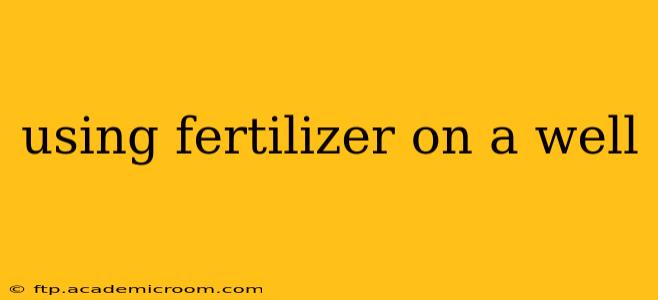Using fertilizer near a well presents potential risks to groundwater quality, posing a threat to human and environmental health. Understanding these risks and adopting best practices is crucial for responsible land management and ensuring safe drinking water. This comprehensive guide explores the potential dangers, provides preventative measures, and offers insights into maintaining both agricultural productivity and water quality.
What are the risks of using fertilizer near a well?
Fertilizers, especially those containing nitrogen and phosphorus, can leach into the groundwater if not properly managed. This contamination can lead to several problems:
- Nitrate contamination: Elevated nitrate levels in drinking water are particularly harmful to infants, causing a potentially fatal condition called "blue baby syndrome" (methemoglobinemia). Adults can also experience health problems from high nitrate intake.
- Eutrophication: Phosphorus runoff from fertilizer can cause eutrophication in surface waters connected to the well, leading to algal blooms that deplete oxygen and harm aquatic life. While not directly impacting the well water itself, this can affect the overall water ecosystem and potentially impact the well's long-term health.
- Other contaminant introduction: Fertilizers can contain other substances, such as heavy metals, which can also contaminate groundwater.
How far away should fertilizer be from a well?
There's no single universally accepted distance. The safe distance depends on several factors:
- Soil type: Sandy soils allow for faster water percolation and increased risk of contamination, requiring greater distances than clay soils.
- Well depth: Deeper wells generally have a lower risk of contamination than shallower ones.
- Fertilizer type: The solubility and mobility of the fertilizer components influence the potential for leaching. Slow-release fertilizers generally pose a lower risk.
- Rainfall patterns: Areas with high rainfall experience increased leaching potential, necessitating greater separation distances.
- Local regulations: Many states and localities have specific setback requirements for fertilizer application near wells. Consult your local health department or environmental agency for relevant regulations.
What type of fertilizers are safest to use near a well?
Slow-release fertilizers minimize the risk of immediate leaching. Organic fertilizers, such as compost, generally release nutrients more gradually than synthetic fertilizers, reducing the chances of groundwater contamination. However, even organic fertilizers should be applied cautiously and with consideration for the factors listed above.
How can I minimize the risk of fertilizer contamination of my well water?
Several strategies can reduce the risk:
- Soil testing: Determine your soil's nutrient content before applying fertilizer. Applying only the necessary amounts minimizes excess fertilizer, reducing the risk of leaching.
- Proper application techniques: Follow the manufacturer's instructions precisely. Avoid over-fertilizing and apply fertilizer at the recommended rate. Consider techniques like banding (placing fertilizer in a narrow strip) to further minimize runoff.
- Timing of application: Apply fertilizer when the plants are actively growing and the soil is moist but not waterlogged to minimize runoff and leaching. Avoid applying fertilizer before heavy rainfall or when the ground is frozen.
- Buffer strips: Planting vegetation along the well's perimeter can act as a natural filter, absorbing excess nutrients before they reach the groundwater. Native vegetation is often the best option.
- Regular well water testing: Monitor your well water quality regularly for nitrates and other potential contaminants. This allows for early detection of contamination and prompt action if necessary.
What should I do if I suspect my well water is contaminated?
If you suspect your well water is contaminated with fertilizer, contact your local health department or a qualified water testing laboratory immediately. They can test your water and advise you on appropriate actions. Do not consume the water until it has been tested and deemed safe.
Can I use fertilizer near a well if it's used for irrigation, not drinking?
Even if your well water isn't used for drinking, contamination can still negatively impact the surrounding environment. The principles of safe fertilizer application remain the same; contamination can still harm aquatic life and potentially affect the long-term health of the well itself.
This information is for educational purposes only and does not substitute professional advice. Always consult with local experts and regulatory agencies before making any decisions regarding fertilizer application near your well. Remember, protecting your groundwater is a responsibility shared by everyone.
